to jump to the article. Summary: Researchers at the Cornell Waste Management Institute analyzed six farms, all with a unique way of incorporating dried manure solids into their herds' bedding. Information provided in this article included the economic implications, the potential for spread of Johne's disease and the impact on a herd's feet and legs. Because this article was so popular, we asked Mary Schwarz of the Institute a follow-up question: Q: Why are dairy producers interested in dried manure solids in 2011? A: Dried manure solids (DMS) are of interest to dairy producers for several reasons. Sawdust, a historic bedding of choice, has been hard to come by for the past several years and can be expensive. Other options include low-quality hay, straw and sand, but each of these has an added cost. Manure, on the other hand, is never in short supply and has to be managed in some way.
Excess nitrogen applied to crop land can be detrimental and is not always an option, so, using manure solids as bedding allows farmers to better manage plant nutrients. Moreover, separating solids reduces manure-hauling costs by moving less material to fields. Dairy producers are interested but are also hesitant to have their animals sit on “manure.” The more information producers can get on making DMS work, the better able they will be to save money without adversely affecting cow health and milk quality.
—Mary Schwarz, Extension Support Specialist, Cornell Waste Management Institute
[Click here or on the image above right to see the full list of the Top 25 articles of 2011. Click here to see the list from 2010.]
ARTICLE
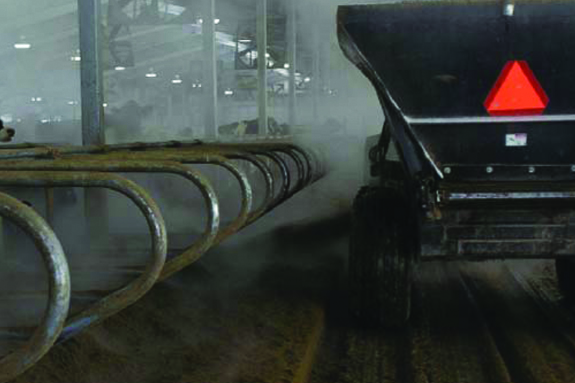
Good livestock bedding sources have become harder for farms to secure. The price of existing sources has increased and then those sources have started to disappear due to the demand for biofuels. At the same time, there is still plenty of manure on farms that might serve a similar purpose if processed by separation, digestion and/or composting.
In many cases we produce more manure than our crops need, which can overload soils with nutrients. Dairies are looking for alternative bedding sources and some have implemented separated or dried manure solids (DMS) as bedding.
There has been concern that wet and cold winters and hot, humid summers would not be good for using DMS and concern over using a bedding that may carry a pathogen load. Some farms seem to be making it work.
Cornell Waste Management Institute (CWMI) contacted farms that had been or were starting to use DMS bedding and conducted research on those farms to determine the feasibility of using manure solids as dairy cow bedding.
The areas of concern for the use of DMS, or any bedding material, revolve around the bacterial and physical properties of the material, their effect on udder health, the health of feet and legs, and the economics of use.
We attempted to answer the following:
• Are bacterial concentrations in the unused and used bedding different between the different farm/bedding strategies?
• Are there physical factors such as moisture and particle size, in the unused and used bedding that are different among the farm/bedding strategies?
• Do the bacterial counts in and/or the properties of the bedding have an effect on udder health?
• Will the use of DMS contribute to the spread of Johnes disease in a herd?
• What are the economic implications of using DMS as bedding?
• What is the impact of the use of DMS on feet and legs?
Research design
Six farms using different types of DMS strategies, including a farm that also used sand as bedding, participated in this study. At each of the farms, we took samples of the bedding material (both unused and used) over a one-year period and analyzed them for bacterial count, the presence of mycobacterium avium paratuberculosis (MAP – the organism responsible for Johnes disease) and physical properties. We looked at farm records of mastitis and somatic cell count (SCC), and performed an economic analysis of the cost savings from using manure solids.
Description of DMS Strategies
• Farm A separated their manure, then put it through a drum composter with a retention time of 24 hours. The bedding was left in a pile for one day and then spread in a 3-inch layer on concrete stalls. Bedding was refreshed three times a week.
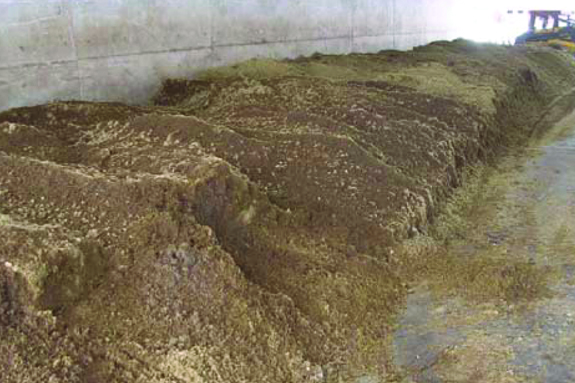 • Farm B separated their manure, then windrow composted it for 10 days before spreading it in a 2-inch layer on mattresses. They put in fresh bedding six times a week.
• Farm B separated their manure, then windrow composted it for 10 days before spreading it in a 2-inch layer on mattresses. They put in fresh bedding six times a week.
• Farm C digested their manure, then separated. They would take the solids from directly under the separator and spread them in a 2-inch to 3-inch layer on mattresses. Fresh bedding was put in the stalls twice a week.
• Farm D separated, then piled their manure for about three days, or used it directly from the separator depending on the volume of solids they had on the days they spread fresh bedding, which occurred twice a week. They used solids in deep beds, which are about 12 to 24 inches. When bedding is refreshed in deep beds, an additional inch or two is added.
• Farm E was just starting to use manure solids when we started the study. This farm had been using sand and leased a drum composter with a 3-day retention time to use solids. The farm used green solids, composted solids, and sand so we could compare the three treatments. Deep beds were refreshed with solids twice a week and sand once a week.
• Farm F piled solids from the separator for seven days and spread them in deep beds twice a week.
Are bacterial concentrations in the unused and used bedding different between the different farm/bedding strategies? (i.e., do the solids need to be composted or prepared in a specific manner?)
Dairy bedding is used to provide cows with a clean, dry, comfortable place in which to lie down. There are two types of bedding: organic, such as sawdust, straw and manure solids; and inorganic, such as sand. Organic bedding materials contain nutrients required for bacterial growth, while inorganic bedding materials do not.
However, once any type of bedding becomes soiled (with fecal matter and urine), pathogen growth can be supported. Inorganic bedding, such as sand, starts out with low pathogen concentrations, and some organic bedding materials start out with lower concentrations than others.
There has been a common rule of thumb that bedding materials should be kept below a maximum bacterial count of 1 million colony forming units per gram (cfu/g) of bedding wet weight. This number appears to be based on one study where there were no new cases of coliform mastitis when bedding counts were at 10,000 and 100,000 one summer, but there were several new cases the following summer when bedding counts were at 10 million cfu/g wet weight. This article does not claim that this is the magic number, but it appears to have been used extensively by farmers, veterinarians and farm advisors.
Bedding can be analyzed for a number of different bacteria, but not all of them will have an effect on udder health. A wide range of microorganisms can invade and infect the udder; however, coliforms (of which E. coli and klebsiella are two) and environmental streptococci are the most important in causing mastitis. Therefore, these bacteria are the ones on which this article will focus.
Unused sand bedding had the lowest bacterial numbers, and composting (both drum and windrow), as well as digesting prior to separation, reduced bacterial numbers in DMS prior to putting it in the stalls ( see figures below ). However, after being in the stalls for one to six days, bacterial levels increased regardless of type of bedding. Story continues below figures.
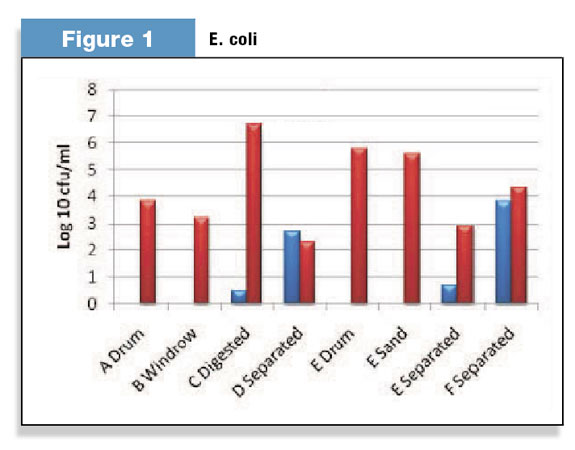
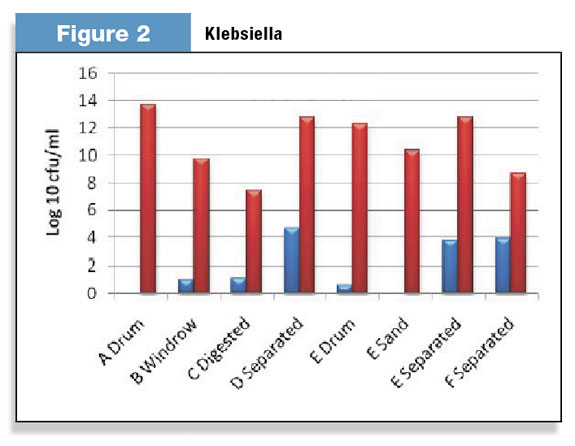
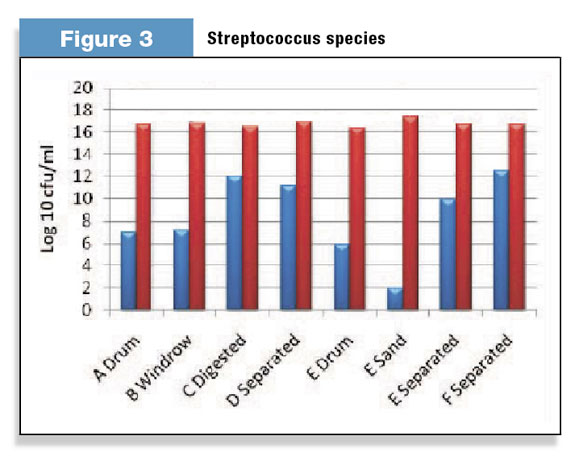
In some cases, those that started out with “clean” bedding tended to have significantly higher levels of bacteria in used bedding, indicating that the bedding may have started out too clean (i.e., no competition from other bacteria).
In addition, the bacterial levels in the used bedding for sand, drum composted and DMS directly from the separator at farm E did not differ from each other.
This indicates that bacterial levels in used bedding are more likely the result of bacteria in the fresh manure of the cow and how well the stalls are cleaned, as well as what is tracked in from the alleys, rather than how “clean” the bedding is when it is put in the stall.
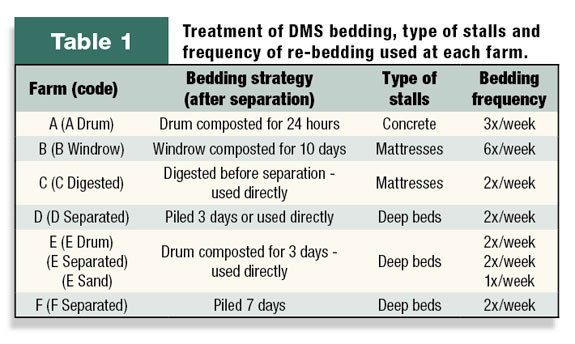
Are there physical factors in the unused and used bedding that are different among the farm/bedding strategies?
It has been suggested in the literature that with more moisture and more organic matter, bacterial populations thrive. It has also been suggested that the amount of fine particles in the bedding has an effect on the bacterial population on the teat ends; the finer the material, the more likely it will stick to the teat ends, and therefore they will have a higher population of bacteria. Bedding (both unused and used) was analyzed for percentage of moisture and particle size.
Average moisture ranged from 64 percent to 73 percent in the unused DMS bedding and fine particles (less than 2 mm in size) ranged from 31 percent to 74 percent. These differences were dependent on the type and efficiency of the separator being used on the farm. Sand, as expected, was drier with only 11 percent moisture and contained 71 percent fine particles.
Average moisture in the used DMS bedding was higher in the bedding strategies that used deep beds (ranging from 43 percent to 60 percent) and lower on those that used mattresses (29 percent to 50 percent). Farms using mattresses spread the DMS in a 2-inch layer on top of the mattress, thus allowing it to dry out.
Fine particles were also affected by type of stall and tended to be lower in those bedding strategies that used deep beds versus those that used mattresses. DMS in deep beds tends to mat together from the weight of the cow, while the DMS on the mattress tends to either fall off or spread out.
Do the bacterial counts in and/or the properties of the bedding have an effect on udder health?
Udder health is measured by incidence of mastitis and SCC. Mastitis is an inflammation of the udder that causes clots in milk. It is generally treated with antibiotics and makes the milk unsalable. SCC is a count of white blood cells in the milk, which can indicate infection.
Mastitis
Mastitis incidence over the course of the study in the pens used ranged from 4 percent to 10 percent. Incidence was different between the farms, but not between the three different bedding strategies at farm E. The factors that affected mastitis incidence on all farms were stage of lactation, milk production and cell count. Bacterial levels and bedding properties had no effect on the number of mastitis events.
Somatic Cell Count
Because mastitis is frequently subclinical, estimating the SCC of a milk sample can detect infection. It has been generally accepted that the cell count for “normal” milk is nearly always less than 200,000 cells/ml for cows and 100,000 cells/ml for heifers. Higher counts are considered abnormal or excessive, and indicate probable infection.
Abnormal SCC over the course of the study in the study pens ranged from 17 percent to 50 percent of the animals. As with mastitis, the number of animals with abnormal SCC was different between the farms, but not between the three different bedding strategies at farm E.
The factors that affected SCC were season, lactation number and stage of lactation. Bedding properties and bacterial concentration did not have an effect on SCC.
Percent of animals with mastitis and abnormal SCC over the course of the study for each farm/bedding strategy.
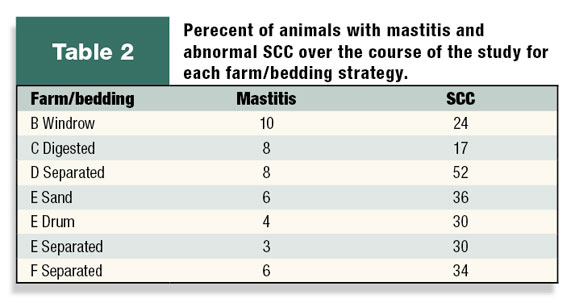
Will the use of DMS contribute to the spread of Johnes disease in a herd?
There is some concern that since the bacteria responsible for Johnes disease (mycobacterium avium paratuberculosis – MAP) is shed in the manure, using manure solids as bedding may spread the disease throughout the herd if the bacterium remains viable in the DMS.
MAP was found in small numbers in several of the unused bedding sources, including sand. In this study, MAP was not consistently destroyed by separation, digestion or drum composting. Therefore, there could be some potential for the spread of Johnes through the use of DMS.
Since the number of colony-forming units was small, that possibility is also small, and may be of concern only in the bedding of calves. Cows do not tend to ingest bedding, where calves may.
What are the economic implications of using DMS bedding?
An economic analysis of using manure solids as bedding was performed. Returns were from the sale of solids, reduced hauling cost (not having to take the manure out in the field for spreading) and reduced costs on purchasing bedding.
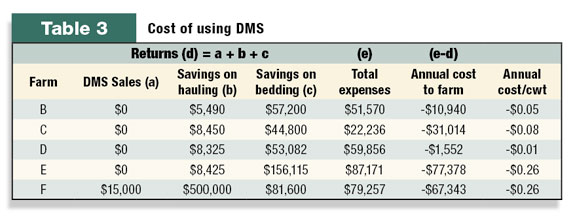
Costs include equipment to separate, other machinery costs, fuel, labor and other costs associated with bedding management. It was calculated as the cost or savings per hundredweight (cwt) of milk produced. In all cases there were savings that ranged from 1 to 26 cents per cwt.
Conclusions
• Using manure solids can provide an economic benefit without adversely affecting herd health.
• Bacterial levels in the bedding alone are not what cause high SCC or mastitis. Management of the bedding in the stalls is much more important than analyzing it for pathogens. Keeping stalls free of manure and urine, regardless of bedding type, will go a long way toward keeping SCC and mastitis under control.
• Use a DMS system that fits into your farm’s routine and one with which you are most comfortable. PD
References omitted due to space but are available upon request to editor@progressivedairy.com
— Excerpts from Cornell Waste Management Institute, Cornell Cooperative Extension






